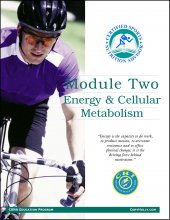You are here
Home ›Module Two: Energy and Cellular Metabolism

Energy is to our lives and performance what the sun is to the solar system or the atom is to the make-up of matter. Energy is what propels us, motivates us and keeps us alive. It alone determines the frequency of everyone's participation in sport, influencing both the volume of training and the intensity of exercise. Fatigue is the athlete's greatest enemy.
Energy controls the initiation and outcome of every process associated with human performance; its presence in surplus or its chronic absence represents the greatest limiting factor responsible for strength, endurance, stamina, growth, recovery and state of mind.
Energy is the secret behind true lasting health and the ability to participate in sport and athletics long term. In this module, you will learn that change is necessary by understanding the basic concept behind metabolism, catabolism and anabolism.
The essence of photosynthesis arid respiration becomes clear, while we study the three laws of thermodynamics and learn how energy is transferred from food to cell. What is kinetic, potential, and activation energy and what makes a calorie? What creates mass action and the mediation, induction, and repression of enzyme activity?
We'll discuss the history of vitamins and how they were discovered, how free radicals are formed and how they leave a trail of damage in the body that can be measured. We'll focus on the importance of antioxidants before, during and after training, and learn why minerals are vital to optimal mental and physical performance. You will move through the structure and history of the cell, our basic unit of life, focusing on the structure and function of its components: the nucleus, cytoplasmic organelles, the cytoskeleton, the centrosome and centrioles, cell inclusions, a variety of chemical constituents, and the almighty mitochondria, the workhorse of the cell.
The next section studies organic compounds, looking deep into protein, its composition, classification, metabolization, relation to muscle tissue, and the essence of maintaining a positive nitrogen balance. As an athlete, you will explore ketones, ketosis, a ketogenic diet, the structure and function of nucleic acids, and the storage capacity and capabilities of ATP, the energy currency of the cell. Carbohydrates, which fuel the machine and function primarily as biological gasoline, are examined in detail, probing their structure, function, metabolic capabilities under aerobic/anaerobic conditions, the vital glucose transport system, glycemic indexes, carbohydrate density, and how it all relates to our athletic performance.
We will examine the structural, functional and metabolic capabilities of lipids, essential fatty acids, phospholipids and cholesterol, and then look at how fat is formed from sugar, fatty acid and glycerol catabolism, and how/why triglycerides form the major reserve of energy potential. The last section investigates inorganic compounds, focusing on the pH of blood, electrolyte chemistry and fluid dynamics, the importance of optimizing pH balance by adjusting the amount of acid/alkaline-forming foods consumed, and their effect on performance. Module Two also reviews oxidation/reduction reactions, the role of ATP in recovery, the electron transport chain, the Krebs cycle, lactic acid as a valuable source of chemical energy, CP/ATP energy pathways, glycolysis and the impact of fuel regulation via the oxidation of fat and carbohydrates in aerobic and anaerobic exercise.

Module Two Table of Contents
Module Two Course Excerpt